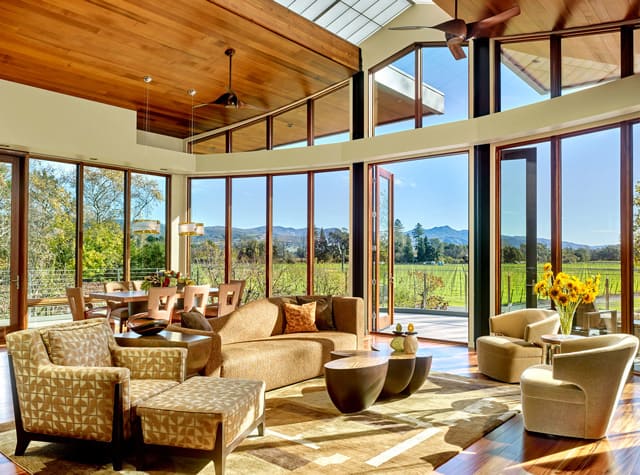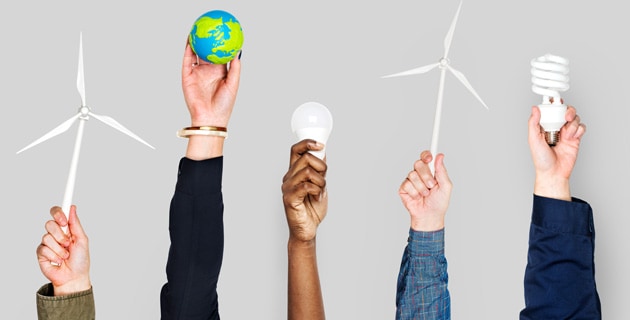We are blessed with an abundant flow of solar energy that can easily meet all of our energy needs. And, we have technologies to extract heat and cooling from the Earth. So why are we so recklessly plugging into the “grid” developed by electric companies and gas utilities? Why aren’t we collectively looking for better options?
In addition to using sustainable energy, we can invest in energy efficiency which saves energy and money. We can improve a home or building’s energy efficiency by reducing the energy spent on heating, lighting, appliances, and other energy-consuming activities.
HEATING

Heating accounts for the highest portion of your electricity bill and home energy consumption. And, heating is the first place to look when the question of how to create an energy efficient home is asked.
In order to ensure energy efficiency and retain heat, ensure that your property is properly air sealed and insulated. Install high-quality windows and curtains, which provide good insulation and prevent the escape of heat. With efficient windows and curtains, room temperature can be regulated by opening and closing windows whenever required. Carpets are also thermal insulators, they can retain about 10% of a room’s heat.
Opt for renewable, non-carbon based sources of energy. Solar heating, which uses the sun’s free energy, is the cheapest and most eco-friendly heating system for home and water. Once set up there is no operating cost. Solar heating could also qualify you for up to a 3% federal rebate for energy efficiency.
Geothermal heating is the next most efficient heating system. It extracts heat from the ground in the winter and cool from the ground in the summer. The installation cost may be high, but it leads to a dramatic drop in energy use.
Heat pumps are another efficient heating system for places with mild winters, and they are much cheaper to install than geothermal systems. They draw heat from the air or ground and thus only require a little electricity to run the pump.
When integrated into the home’s architecture, passive solar allows the winter’s sunlight to enter your home, while keeping it blocked out in the summer. When supported by solar-powered radiant floors, many homes can get through winter without any energy from the grid (electricity or gas).
COOLING

Proper air sealing and insulation, and the use of top quality windows and curtains, also help keep homes cool. Use the surrounding landscape to create a space with shade. Use a lighter exterior wall paint which reflects heat. Ensure that all spaces have sufficient ventilation. Installing radiant barriers in roof rafters, roof vents, or solar roofs help keep spaces cool. Ceiling fans, which are much cheaper than air conditioners, keep spaces comfortably cool. Thermal siphoning, a process where hot air is removed through controlled airflow is an energy efficient way of keeping your home cool.
As mentioned above in the heating section, a geothermal system is the most energy efficient, and it works wonders for cooling too. The installation is expensive, but you will save up to 50% on cooling bills when compared to traditional air conditioners in hot climates. If your home and climate are conducive, you can totally eliminate the need for grid energy for cooling.
Another way to conserve energy and save costs is an ice cooling system. It involves freezing large tanks of water into ice at night when the energy demand is low and pumping the cool air into the building the next day. This system is expensive to install and requires a lot of space. Although, if you are looking at how to design an energy efficient home, it should be considered.
LIGHTING
 Image Source : Susan Hersker
Image Source : Susan Hersker
An easy start towards creating an energy efficient home is by replacing traditional incandescent bulbs with energy and cost-efficient light bulbs such as halogen incandescents, compact fluorescent lamps (CFLs), and LED lights. Energy efficient bulbs use 25 to 80% less energy than incandescent bulbs and can last 3 to 25 times longer. Available in a range of colors, these bulbs will fit into your homes and needs easily.
Another great way to save on electricity is to design spaces in such a way that you can make optimal use of natural light. Lighter wall colors and tiles are reflective and increase the amount of light in a room, without artificial lighting.
You could also install an occupancy sensor, which turns on the lights when a room becomes occupied and turns it off when unoccupied. These can be used in conjunction with a daylight control, which keeps lights off when there is ample natural light.
ECO-FRIENDLY SYSTEMS & DEVICES

There are a vast number of eco-friendly devices that can help improve the energy efficiency of your home.
Smart thermostats learn the patterns of how and when you use the heating and air conditioning systems and thus help in smart energy savings. To avoid doubts of whether you left the lights or the coffee maker on, invest in an energy management system. With these systems, you can control lights, ventilation, appliances, and security systems through a remote or smartphone. They also allow you to monitor your energy use.
Something we learn when we look into energy efficiency is that your home systems are as important as your personal decisions to use fewer lights and appliances. Meaning that the onus is on the architect and designer to set the homeowner up for success. A well-built home using passive solar design, geothermal heating, and solar panels for electricity, can literally run off-the-grid (with no hookups to utility companies).
Sustainable designs can be found throughout the country, with many sun-drenched places leading the way, such as the “Earthships” in New Mexico to the many off-the-grid homes in Hawaii that depend on sun and water catchment. It is even becoming increasingly popular to use solar panels to charge electric vehicles, further reducing our carbon footprint.
Let’s together make this world a better place through energy conservation. ♥


